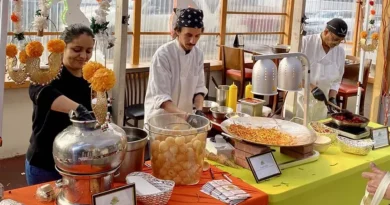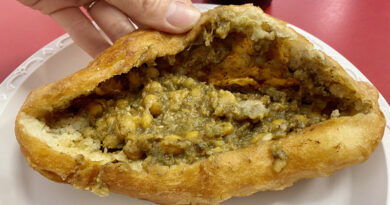Get to Know Traditional Chilean Food
Despite the country’s name, typical Chilean foods are generally not spicy, but they are certainly delicious and diverse, thanks to Chile’s incredibly varied geography. Imagine what results when you combine the driest desert in the world with the rich agricultural lands in the central valleys and the cold, windy grasslands of Patagonia. And let’s not forget this country’s nearly 4,000 miles of coastline!
The following traditional dishes–and the restaurants in Chile that offer them–are a great starting point for getting to know Chilean cuisine. Here’s how to eat like a local in Chile.
Empanadas Chilenas
If you ask a Chilean what the national dish is, the answer will likely be the empanada de pino, a baked, meat-filled turnover. Although various types of empanadas can be found across South America, it’s the pino filling that makes Chile’s version special.
In fact, the pino is an essential component of not only the empanada, but also the corn and meat pies–called pastel de choclo, see below–that are popular in Chile. The pino consists of ground or minced beef cooked with finely chopped onion, spices (oregano, cumin, paprika), hard-boiled egg, olives, and sometimes raisins. Pino can also be spicy (mixed with ají), if requested; you can ask for your pino con (with) aji or sin (without) aji.
Over time, Chileans have created both baked and fried empanadas filled with fruits, meats, vegetables, and more. After pino, cheese is the second most coveted filling; fried cheese empanadas (empanadas de queso) are often served as an appetizer in pubs and restaurants. Other popular varieties include the fried empanada de pino (which is the same as the baked version but without the hard-boiled egg), the baked or fried empanada de mariscos (seafood), and the fried camarón con queso (shrimp and cheese). They are usually made in varying shapes to differentiate them; for example, spicy empanadas de pino tend to be triangular. All are made with wheat flour, since corn flour isn’t used in Chilean cuisine.
Where to find it: Empanadas–whether frozen, ready-to-eat, or freshly prepared–are found almost everywhere, from small diners and bakeries, markets and grocery stores. They are a fast and easy lunch for many Chileans on the go. But they can also be enjoyed in more relaxed environments, in restaurants or at home gatherings.
You can try some great baked empanadas at the traditional Empanadas La Tinita, in the Providencia Market in Santiago (map) and at the many Castaño bakery shops in Santiago and the city of Viña del Mar, on the central coast. Restaurants in the countryside town of Pomaire, close to Santiago, specialize in preparing huge empanadas de kilo weighing roughly 2.2 pounds! Some of the best fried seafood empanadas are those served at the eateries in Mercado de Cauquenes (map), in the Maule region, about three hours south of Santiago.

Pastel de choclo
Pastel de choclo is one of the famous traditional dishes of Chilean cuisine and my personal favorite! Every bite is an explosion of heavenly flavor. Similar to a shepherd’s pie, this sweet corn casserole, traditionally served in a clay bowl, is filled with pino, half of a hard-boiled egg, olives, raisins (optional), and one or two chicken drumsticks (although some places use boneless). Then it’s covered with a thick corn puree. It’s all baked until it’s piping-hot and browned on top.
You will often find that pastel de choclo is coated with a very generous amount of sugar on top, mostly to give it that ideal golden-brown color when it cooks, but some people find it’s not necessary. You might want to ask if there’s sugar in the one you are buying, in case you don’t want the extra sweetness.
Where to find it: This typical dish is found at almost all Chilean food restaurants, especially during the summer, when the sweet corn used is available. For a great pastel de choclo in Santiago, head to Galindo (map) in the Bellavista neighborhood or Empanadas La Tinita in the Providencia Market in Santiago (map). Or drive out to Los Secretos De Anita (map) in the countryside town of Pomaire, close to Santiago.

Chorrillana
The chorrillana is a very popular Chilean dish, and a go-to at any pub or bar in the country. It even has its own national day, celebrated each August 13. Chorrillana consists of a large plate of French fries topped with fried onions, fried eggs (sunny-side up), and minced beef, or other meats, depending on the region, that may also include minced pork and chorizo. When you order it, you’ll probably be asked if you want a chorrillana for one or two people. And you should know that the serving for two can feed four!
Where to find it: You can find chorrillana easily in restaurants, bars, and pubs throughout Chile. But you should definitely try it at J.Cruz, the restaurant-bar that made this dish popular in Valparaíso (map), Chile’s main port city. A great place to taste it in Santiago is the (German) Elkika Ilmenau (map) diner, in the Providencia neighborhood.

Machas a la Parmesana
Machas a la parmesana is a mouth-watering Chilean dish that’s a popular appetizer around the country. Pink clams are sprinkled with salt, white wine, butter, and Parmesan cheese, and then roasted until the cheese melts. What’s not to love, right? They should be served on a platter as soon as they’re ready, and thoroughly enjoyed with a chilled glass of Chilean white wine.
Where to find it: Most restaurants along Chile’s coast will have this dish on the menu. But some favorite places to get machas a la parmesana include Club Árabe aka Castillo del Mar in Viña del Mar (map) and Donde Augusto in Santiago’s central market (map). Three hours south of the capital, Hostería Iloca (map), in the Maule region, is a great spot for this.

Caldillo de Congrio
The hearty stew called caldillo de congrio is so delicious it inspired a poem: Chilean Nobel Prize winner Pablo Neruda loved this dish so much that he penned The Ode to Conger Chowder. To this day, many fans consider his “recipe” the best one and strive to honor it. It basically consists of conger eel, shrimp, potatoes, tomatoes, garlic, onion, and heavy cream, among other ingredients. The resulting soup is perfection, and beloved by Chileans.
Where to find it: Of course, you’ll probably find the best version of this dish at the restaurant honoring the poet: Mesón Nerudiano (Nerudian Table) in the Bellavista neighborhood of Santiago (map). Other great places to try it are the Divertimento Chileno at the Pedro de Valdivia entrance to Cerro San Cristóbal in Santiago (map) and Tres Peces in Valparaíso (map).
Locos Mayo
Although loco means “crazy” in Spanish, this dish actually refers to the mollusk known as Chilean abalone. It usually consists of four abalones atop a bed of lettuce, served with a cilantro-based green sauce and a potato salad on the side. So good it will drive you nuts!
Where to find it: Most restaurants specializing in fish and seafood will offer locos mayo. One of my favorite places to eat this is Hostería Iloca (map) on the coast of the Maule region, about three hours south of Santiago. Another great option nearer the capital is Donde Willy in Viña del Mar (map), the beach area closest to Santiago.

Mote con Huesillo
The jury’s still out on whether mote con huesillo is a dessert or a (nonalcoholic) drink, but either way it’s a must, especially when served cold on a hot summer day. It’s made from dried peaches (the huesillo) boiled in water with molasses, cinnamon, and cooked wheat berries (the mote), served in a tall glass in layers: wheat at the bottom, then the peaches, then the liquid. You’ll usually get a spoon to help you eat the peaches. It’s chewy and sweet, and truly refreshing.
Where to find it: Mote con huesillo is a typical street food that you can find across Chile, including grocery stores. But here’s an insider tip: If you climb to the top of Cerro San Cristóbal–Santiago’s highest hill, in the Bellavista neighborhood–you’ll find a kiosk that, in my opinion, serves the best mote con huesillo. It feels like a reward, and you’ll get some incredible views of the city!

Dulces Chilenos
Dulces chilenos (Chilean sweets) is the generic term for a variety of pastries made with a soft dough and filled or covered with manjar (boiled condensed milk, similar to dulce de leche), merengue, or both. The combinations are truly delicious! The most common types of Chilean sweets are alfajores (stacked cookies filled with manjar), principes (two elongated wafers filled with manjar and covered with merengue), and empolvados (two fluffy biscuits filled with manjar and sprinkled with powdered sugar).
Where to find it: You can find dulces chilenos practically everywhere in Chile, including bakeries, cafés, and grocery stores. You’ll even see people selling them in baskets at toll booths on the highways. However, one of the most typical places where they are made and sold is the Curacaví valley, approximately 45 minutes west of Santiago by car. I recommend stopping along Ruta 68 at either Millahue bakery (map) or Agua de Piedra (map), to try some delightful pastries with tea.
About the author: Marcela Torres is a bilingual freelance journalist from Chile with a passion for exploring, learning, and bringing people together by highlighting their shared experiences and concerns. You can find her online at https://marcelatorreschile.wixsite.com/writer.





